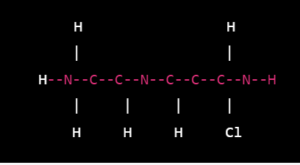Procyclidine Hydrochloride
Structure –
Procyclidine hydrochloride is a medication used to treat symptoms of Parkinson’s disease and certain side effects of antipsychotic medication. It is available in the form of tablets and injections.
The chemical structure of procyclidine hydrochloride is:
This molecule consists of a piperidine ring with four substituents: a methyl group (CH3), a phenyl group (C6H5), an N,N-diethylcarbamoyl group (NEt2CO), and an N-cyclohexyl-3-piperidinol group (NCH2C6H11OH). The hydrogen atom (H) attached to the nitrogen (N) in the piperidine ring is replaced with a chloride ion (Cl-) to form the hydrochloride salt.
Synthesis –
The synthesis of procyclidine hydrochloride involves several steps. Here is a general overview of the process:
- Synthesis of 4-cyclohexylpiperidinol: 4-cyclohexylpiperidinol is synthesized by reacting cyclohexanone with ammonia and formaldehyde in the presence of sodium bisulfite. The resulting product is then reduced with sodium borohydride to yield 4-cyclohexylpiperidinol.
- Protection of the amino group: The amino group in 4-cyclohexylpiperidinol is protected by reacting it with diethylcarbamoyl chloride in the presence of triethylamine to form N,N-diethylcarbamate.
- Alkylation of the nitrogen: The nitrogen in the piperidine ring of N,N-diethylcarbamate is alkylated by reacting it with 1-bromo-3-chloropropane in the presence of potassium carbonate to yield N-(3-chloropropyl)-N,N-diethylcarbamate.
- Cyclization: The N-(3-chloropropyl)-N,N-diethylcarbamate is then cyclized by heating it with potassium hydroxide in the presence of ethanol to form procyclidine.
- Salt formation: The procyclidine is then converted into its hydrochloride salt by reacting it with hydrochloric acid in a suitable solvent.
The final product is procyclidine hydrochloride, which has the chemical structure as shown in the previous answer.
SAR –
- The structure-activity relationship (SAR) of procyclidine hydrochloride is not well-established due to limited research on its mechanism of action. However, it is known to act as an anticholinergic medication by blocking the activity of acetylcholine in the central and peripheral nervous systems.
- Procyclidine hydrochloride’s SAR can be understood based on the structural features of the molecule. The piperidine ring is an essential component of the molecule, which contributes to its anticholinergic activity. The cyclohexyl group attached to the piperidine ring provides steric hindrance, which affects the binding of the molecule to acetylcholine receptors. The N,N-diethylcarbamate group and the N-cyclohexyl-3-piperidinol group also contribute to the overall activity of the molecule.
- In general, the SAR of anticholinergic medications is characterized by a balance between their affinity for acetylcholine receptors and their selectivity for muscarinic receptors. In the case of procyclidine hydrochloride, it has been found to have a higher affinity for M1 and M3 muscarinic receptors compared to M2 and M4 receptors.
- Overall, the SAR of procyclidine hydrochloride is still being studied, and further research is needed to fully understand its mechanism of action and optimize its therapeutic potential.
Mechanism –
Procyclidine hydrochloride is an anticholinergic medication that works by blocking the activity of the neurotransmitter acetylcholine in the central and peripheral nervous systems. Its mechanism of action is believed to involve the following:
- Competitive inhibition of acetylcholine receptors: Procyclidine hydrochloride binds to acetylcholine receptors in the central and peripheral nervous systems, preventing the binding of acetylcholine. This results in a decrease in the activity of cholinergic neurons and a reduction in the effects of acetylcholine.
- Inhibition of muscarinic receptors: Procyclidine hydrochloride has a higher affinity for M1 and M3 muscarinic receptors than for M2 and M4 receptors. This selectivity results in a greater inhibition of the activity of cholinergic neurons that express M1 and M3 receptors.
- Prevention of acetylcholine synthesis: Procyclidine hydrochloride can also inhibit the activity of the enzyme choline acetyltransferase, which is responsible for the synthesis of acetylcholine. This further reduces the availability of acetylcholine in the nervous system.
- Prevention of acetylcholine release: Procyclidine hydrochloride can also inhibit the release of acetylcholine from cholinergic neurons, further reducing the amount of acetylcholine in the nervous system.
Overall, the mechanism of action of procyclidine hydrochloride involves a combination of inhibitory effects on acetylcholine receptors, synthesis, and release, resulting in a reduction in the activity of cholinergic neurons in the nervous system. This activity is responsible for its therapeutic effects in the treatment of Parkinson’s disease and certain side effects of antipsychotic medication.
Uses –
Procyclidine hydrochloride is a medication with several uses, including:
- Treatment of Parkinson’s disease: Procyclidine hydrochloride is used as an adjunct therapy in the treatment of Parkinson’s disease, a progressive neurological disorder that affects movement. It is used to reduce the side effects of antiparkinsonian medications, such as tremors and rigidity, by blocking the activity of acetylcholine in the central nervous system.
- Treatment of extrapyramidal symptoms: Procyclidine hydrochloride is also used to treat extrapyramidal symptoms, which are side effects of antipsychotic medication that affect movement. These symptoms include dystonia, akathisia, and Parkinsonism. Procyclidine hydrochloride can reduce the severity of these symptoms by blocking the activity of acetylcholine in the central nervous system.
- Treatment of drug-induced parkinsonism: Procyclidine hydrochloride is used to treat drug-induced parkinsonism, which is a side effect of certain medications, such as antipsychotics and antiemetics. It is used to reduce the severity of tremors, rigidity, and other motor symptoms by blocking the activity of acetylcholine in the central nervous system.
- Anesthesia: Procyclidine hydrochloride can be used as a preoperative medication to reduce the secretions in the respiratory tract and reduce the risk of aspiration during anesthesia.
Overall, Procyclidine Hydrochloride is a medication that is primarily used to treat the side effects of other medications that affect movement, such as antipsychotic and antiemetic drugs, as well as a supportive therapy in the treatment of Parkinson’s disease.


